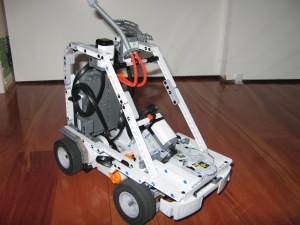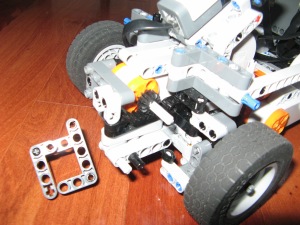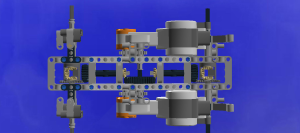Hello! I present to you the much anticipated third generation of the ThunderSmart! It is the most advanced model of my long-running NXT Smart car line. Read on to check out the innovative technology that made its way into the TSIII.
See a video of the ThunderSmart III here: https://www.youtube.com/watch?v=d-FWA8IYlNA
Styling
The TSIII is one slick roller. It encompasses many design cues from the earlier ThunderSmarts. It has the TSI’s front bumper and the TSII’s fenders, to name a few. Like all ThunderSmarts, the TSIII has a simplistic design language. It has flat surfaces that give it the look of a muscle car. The long, flat hood is reminiscent of the powerful Mercedes-Benz G-Wagon. It also has the three signature design cues every ThunderSmart must have; Thunder’s “Shoulder Blade” on the top left of the car, a lightning rod on the roof, complete with realistic red cables, and most importantly, the patented Thundercharger placed jauntily on the hood.
Steering
The TSIII is the first ThunderSmart to have Rack-and-Pinion steering. Rack-and-Pinion steering works when a motor rotates a pinion (round) gear. This pinion grabs the teeth on the rack (the long, flat gear). The pinion then slides the rack side-to-side, which causes the front wheels rotate. The TSIII’s steering mechanism is similar to the ones used in real cars today, with one key difference; The rack gear is mounted longitudinally (lengthwise). I decided to build the steering this way because the NXT motor that drives the steering has the power output on the side of the motor. Mounting everything longitudinally allows the TSIII to retain its sleek, low hood. Here’s the interesting part, though; only the left wheel is connected to the steering rack. The right wheel is joined to the left wheel with a track rod that reaches across the front of the differential. The steering in the TSIII is nearly identical to that of the Plethora. The main picture to the left shows the steering mechanism with the retainer removed so the rack is visible. The second picture shows the mechanism with the retainer, and the last shows the track rod that connects the two wheels.
Drivetrain
Whilst building Terminal Velocity a couple of months back, I had a revelation; the only way to make my cars fast enough to satisfy my need for speed was to use as many drive motors as mechanically possible. As a result, the TSIII and all of my future speed machines will employ dual-motor drive. The advantage is more free power, the ability to use taller gear ratios and better performance when the battery power runs low. The TSIII uses two NXT motors to power its All-Wheel Drive. They are hard-coupled with an axle that runs between them. Their power is relayed to the front and rear differentials with a 1:3 gear ratio on a 90 degree connection. The front and rear drive shafts that carry power into their respective diffs spin in opposite directions, so the diffs are placed with their gear rings on the same side, to ensure that the front and rear axles spin in the same direction. There is no center differential here; just two, old-fashioned 90 degree diffs. The front axle has Universal joints that allow the front wheels to continue turning, even when the car steers. The AWD system is very robust and allows the TSIII to race across thick carpet with minimal speed loss, making it a great rally car.
Sensors and Program
The TSIII employs three sensors; in port 2, a HiTechnic Angle sensor that acts as a steering wheel; in port 3, an NXT Color sensor (listed as “Light sensor” in the quick facts); finally, in port 4, there’s a HiTechnic Infrared Receiver. I created a very complex NXT-G program for the TSIII. (Let me say this; I despise the NXT-G. It’s like the Rube Goldberg of programming. You have to create a program that’s needlessly complex to do something very simple, like in this situation. I would have used EV3-G, but it doesn’t support the HT IR sensor.) Anyway, the program allows you to select three different drive modes for the TSIII. Scanning three different colors into the color sensor allows you to select the mode. When you first activate the program, the TSIII automatically defaults to “Race Mode,” where you control the car with an IR remote. Scan a blue brick, and you’ll activate “Police Mode,” essentially the same thing as Race Mode, but the Color sensor also flashes like a Police siren. Scan a green brick, and you’ll activate “Steer-By-Wire Mode,” a mode made just for fun, where you use the steering wheel attached to the HT Angle sensor to manually steer the front wheels. you can switch between every mode while in that one program, thanks to the color sensor.
Conclusion
This is the fastest, most technologically advanced and most fun ThunderSmart to date. I very much enjoy racing the TSIII and am very satisfied with the outcome. It has no mechanical “gremlins” (Unless you count the steering rack sliding out of place every now and then; a problem that wouldn’t exist if I hadn’t run out of pieces). I may be turning the ThunderSmart out to pasture; unless, of course, you want me to create the ThunderSmart IV! But, until then, I will be working with the EV3. Thanks for reading, and see you next time!






